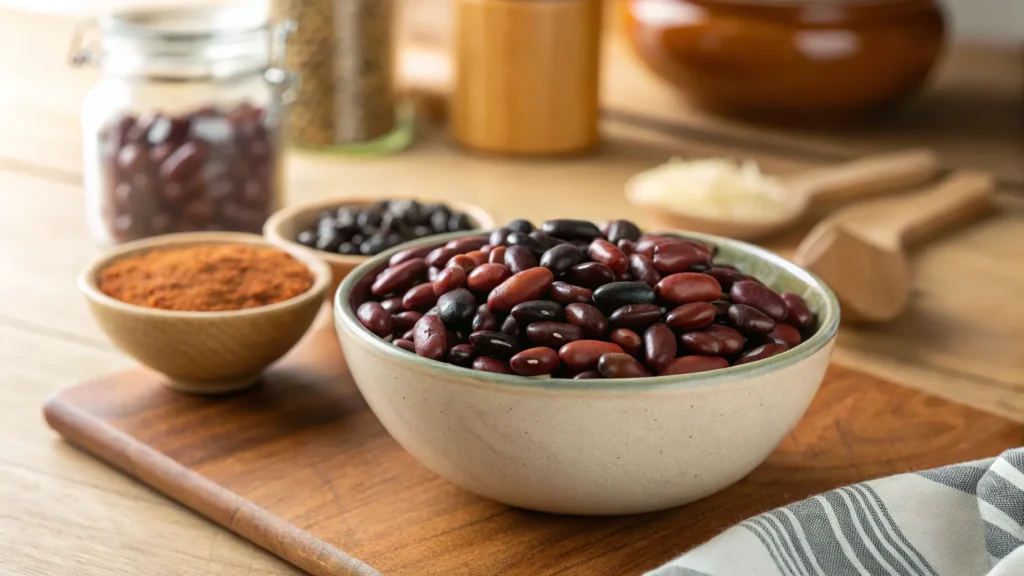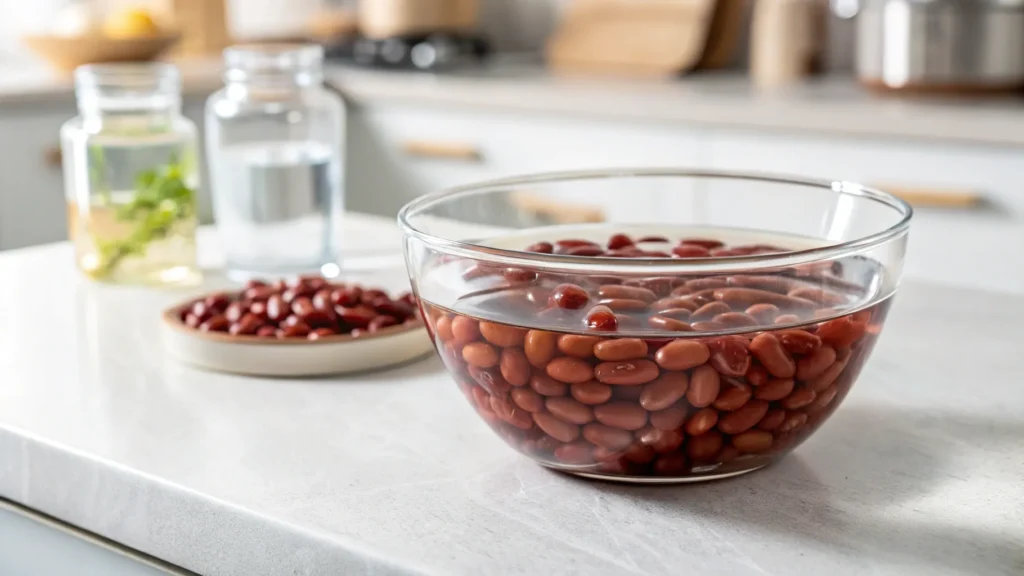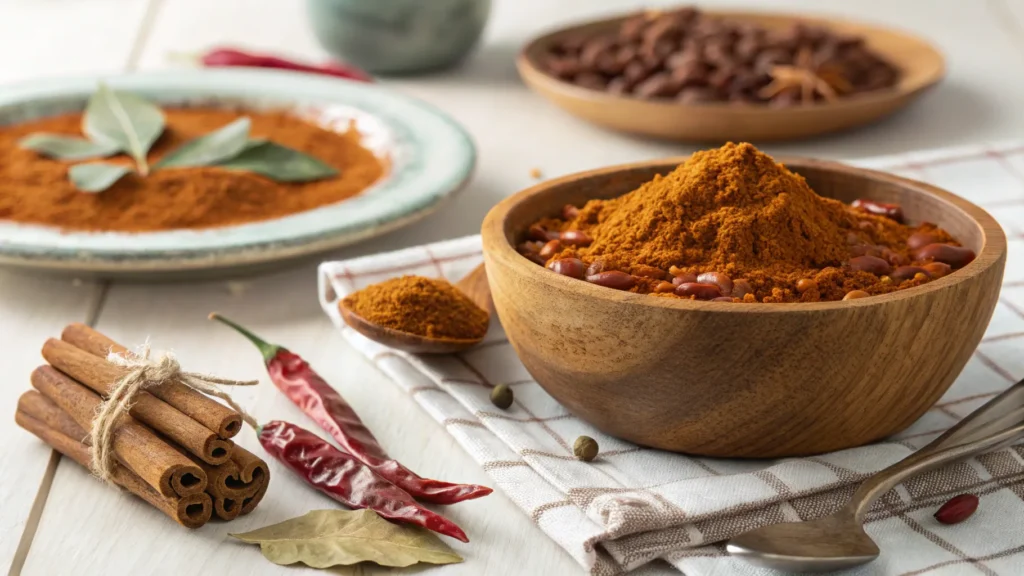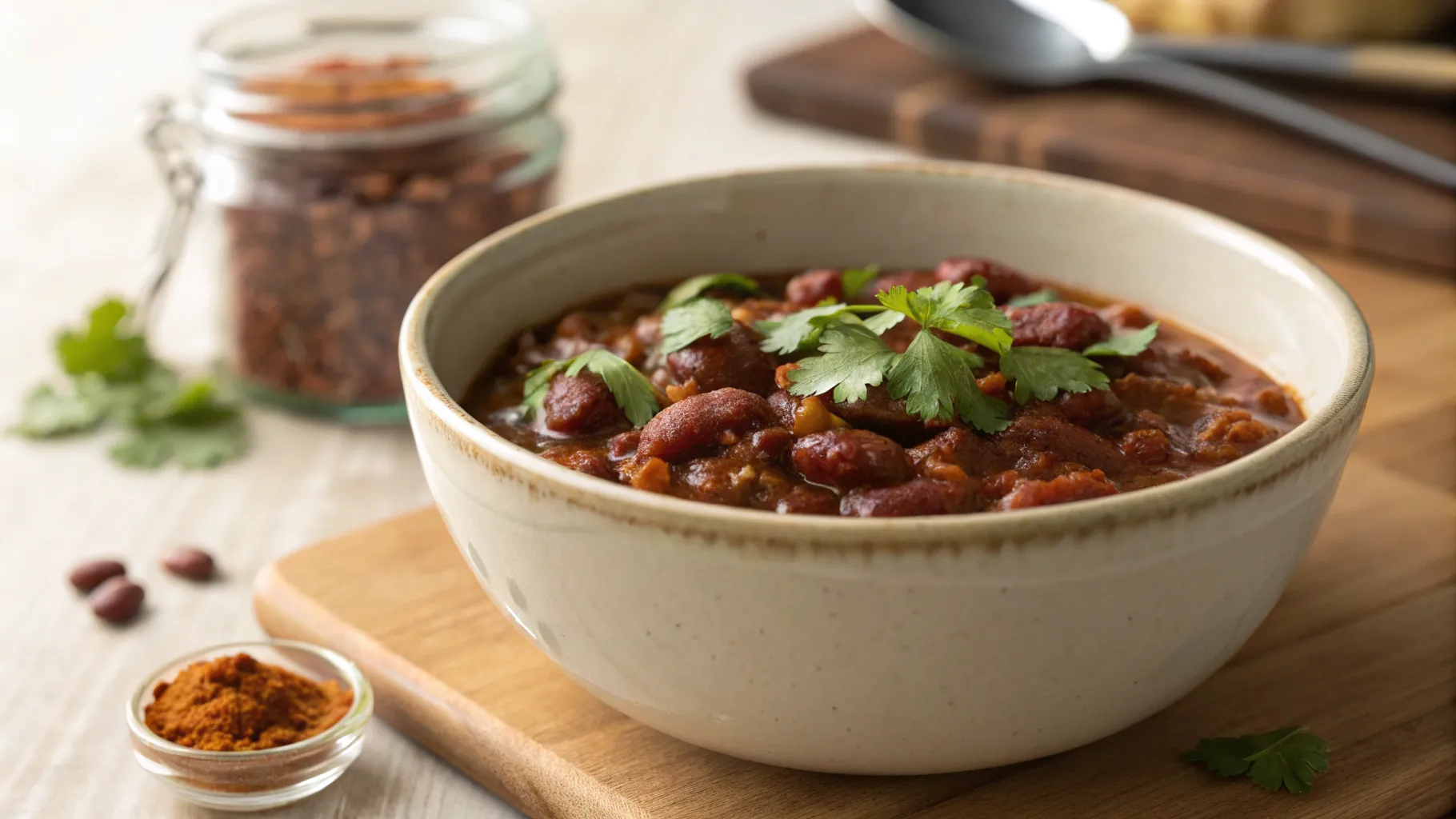Ever thought about using dry beans to make your chili amazing? Most people stick to canned beans. But dry beans can take your chili to the next level, adding real flavor and texture.
Dry beans are more than just a pantry item. They’re a secret ingredient that can make your chili stand out. Unlike canned beans, dry beans give you richer flavors, better texture, and full control over seasoning and cooking.
Both professional chefs and home cooks agree: dry beans are the best choice for chili. With the right methods, you can achieve flavors and textures that canned beans can’t match. Discover how to make chili with dry beans and elevate your recipe to the next level.
Table of Contents
Why Dry Beans Are Perfect for Your Chili Recipe
Cooking with dried legumes makes your chili special. Dry beans have many benefits that canned beans don’t. They are great for anyone wanting to improve their bean cooking.

Cost Benefits of Using Dry Beans
Using dry beans saves money. They are cheaper than canned beans. One pound of dry beans can make six cups of cooked beans, which is like four to five cans.
- Typically costs 1/3 the price of canned beans
- Bulk purchasing offers even greater savings
- Reduces overall meal preparation costs
Environmental Impact of Choosing Dry Beans
Choosing dry beans makes your chili better for the planet. They reduce packaging waste and lower carbon footprint compared to canned beans.
| Environmental Factor | Dry Beans Impact | Canned Beans Impact |
|---|---|---|
| Packaging Waste | Minimal | Significant |
| Carbon Footprint | Lower | Higher |
| Transportation Energy | Reduced | Increased |
Flavor Enhancement Potential
Dry beans soak up seasonings magnificently, making your chili taste better. They are perfect for those who love rich flavors in their chili.
“The secret to an unforgettable chili lies in the beans.” – Professional Chef
Can You Use Dry Beans for Chili? Understanding the Basics
Wondering if you can use dry beans for chili? The answer is a big yes! Dry beans are a great choice for chili, adding unique flavor and texture. Preparing beans might seem hard at first, but you’ll get the hang of it quickly.
Dry beans have many benefits for chili:
- Better control over texture
- More intense flavor development
- Lower sodium content
- More cost-effective option
When thinking about using dry beans for chili, remember preparation is crucial. Unlike canned beans, dry beans need extra steps. You’ll need to sort, rinse, and soak your beans before cooking. This might take more time, but it’s worth it for the flavor.
The most common dry beans for chili are kidney, pinto, and black beans. Each type adds its own special touch to your dish. Feel free to try different combinations to find your favorite.
Pro tip for bean preparation: Always check your beans for any small stones or damaged beans before soaking. This simple step ensures a smoother cooking experience and better-tasting chili.
Essential Types of Dry Beans for Classic Chili
Choosing the right bean types can make your chili recipe stand out. Each bean adds its own flavor and texture, making every bite special.
When making the perfect chili, knowing about bean varieties is key. Each type has its own special qualities that can make your dish better.
Kidney Beans: The Traditional Choice
Kidney beans are the top pick for classic chili. They have a meaty texture and a deep red color. These beans:
- Hold their shape well during cooking
- Absorb spices exceptionally
- Provide a hearty, substantial bite
Pinto Beans: The Tex-Mex Favorite
Pinto beans add a creamy texture to chili. They’re a hit in Southwestern dishes. These beans:
- Offer a mild, earthy flavor
- Create a rich, velvety consistency
- Complement bold chili spices perfectly
Black Beans: Adding Depth and Color
Black beans add a unique color and a nutty flavor to chili. They’re a favorite in southwestern dishes. They:
- Provide a striking visual contrast
- Pack a nutritional punch
- Offer a slightly firmer texture
“The secret to an amazing chili is selecting the right beans that complement your spices and cooking style.” – Chef Maria Rodriguez
Try mixing different beans to find your favorite chili recipe. Don’t hesitate to mix and match to create a dish that’s all your own.
Proper Soaking Methods for Dry Beans

Getting your dried beans ready for chili is key. Knowing the right soaking method can change the texture, cooking time, and taste of your dish.
Soaking beans is not just optional; it’s essential. It turns hard dried beans into soft, tasty ingredients. Let’s look at the best ways to soak:
- Overnight Soak Method
- Cover beans with cold water
- Let sit for 8-12 hours
- Best for advanced meal planning
- Quick Soak Technique
- Boil beans for 2-3 minutes
- Remove from heat
- Let stand for 1 hour
- Ideal for time-sensitive cooking
- Hot Soak Method
- Bring beans to boil
- Let sit in hot water for 2-4 hours
- Reduces cooking time
“Soaking isn’t just about softening beans – it’s about unlocking their full potential in your favorite recipes.” – Culinary Expert
Pro tip: Always drain and rinse your dried beans after soaking. This helps remove excess starches and reduces potential digestive discomfort. Not all beans require soaking, but most benefit from this preparation method.
Your choice of soaking method depends on your schedule and cooking preferences. Each technique offers unique advantages in preparing the perfect beans for your chili.How to Prepare Dry Beans for the Perfect Chili
Preparing dry beans for chili is all about detail. It’s a crucial step for your ultimate chili recipe. With a few techniques, you can turn simple dry beans into a tasty meal.
Cooking dry beans might seem hard, but it’s easy once you know how. You’ll become a pro at preparing beans in no time.
Sorting and Cleaning Your Beans
Before cooking, follow these important steps:
- Spread beans on a clean surface
- Remove any stones, debris, or damaged beans
- Rinse thoroughly under cool running water
Testing Bean Freshness
Fresh beans are key for great chili. Here’s how to check:
- Look for uniform color and shape
- Ensure beans are free from moisture or mold
- Check packaging date if possible
“Fresh beans are the foundation of great chili” – Chef’s Wisdom
Pre-Cooking Considerations
When cooking dry beans for chili, remember these points:
- Soaking time varies by bean type
- Use cold water for initial soaking
- Salt can toughen beans, so add near end of cooking
Pro tip: Patience is key in bean preparation. Slow and steady cooking ensures tender, flavorful beans every time.
For more cost-efficient cooking ideas, try pairing chili with a healthy drink like homemade carrot juice.
Common Mistakes to Avoid When Using Dry Beans
Cooking with dry beans can be tricky, like when making chili. Many home cooks make mistakes that can ruin their bean cooking. Knowing these common mistakes will help you make delicious, perfectly cooked beans every time.
- Salt Timing: Adding salt too early can prevent beans from softening properly. Salt makes bean skins tough, taking longer to cook.
- Incorrect Soaking: Skipping soaking for dry beans leads to uneven cooking and longer times.
- Old Bean Problems: Using expired or stale dry beans means they won’t soften, no matter the cooking time.
Bean cooking needs patience and attention to detail. A big mistake is not checking bean freshness before cooking. Dry beans should be smooth, uniform in color, and free from moisture or damage.
“The secret to perfect beans is understanding their unique cooking requirements.” – Chef Maria Rodriguez
When preparing dry beans for chili, always inspect them carefully. Throw away any beans with visible cracks, discoloration, or moisture. This simple step can greatly improve your bean cooking results.
- Sort beans before cooking
- Rinse thoroughly
- Check for freshness
- Use appropriate soaking methods
Temperature and cooking time are key in successful dry beans preparation. Low, steady heat helps beans cook evenly without breaking down. Avoid high-temperature rapid boiling, which can cause beans to split or become mushy.
Time-Saving Tips for Cooking with Dry Beans
Cooking dry beans doesn’t have to take a lot of time. With smart strategies, you can quickly turn soaked beans into tasty meals. Here are some easy ways to make cooking dry beans faster and more convenient.
Pressure Cooker Magic
A pressure cooker is a big help when cooking dry beans. It cuts down cooking time a lot compared to cooking on the stovetop. Soaked beans cook in 10-15 minutes, and unsoaked beans take about 30-40 minutes.
- Rinse and sort dry beans before cooking
- Add 3-4 cups of water per cup of dry beans
- Avoid filling the pressure cooker more than halfway
- Use natural release method for best texture
Batch Cooking Strategies
Cooking dry beans in big batches saves a lot of time. Make a big pot of beans and divide them into portions for easy reheating.
- Cook 2-3 pounds of beans at once
- Store in airtight containers
- Freeze for up to 3 months
- Thaw in refrigerator before use
Smart Storage Solutions
Storing beans properly is key to keeping them fresh. Store uncooked beans in a cool, dark place. Cooked beans should go in the fridge or freezer.
“Batch cooking dry beans is like having a culinary time machine – prepare once, eat multiple times!” – Home Cooking Expert
Using these tips, cooking dry beans becomes easy and fits well into your busy schedule.
Nutritional Benefits of Using Dry Beans in Chili
Dry beans are nutritional powerhouses that make your chili a health-packed dish. Choosing dry beans for your chili means you get more nutrients than canned beans.
Bean nutrition brings health benefits to your favorite comfort food. Each serving of dry beans gives you a big protein boost. This helps you feel full and energized.
- High protein content: Up to 15 grams per cup
- Rich in dietary fiber: Supports digestive health
- Low sodium levels compared to canned beans
- Essential minerals like iron and magnesium
How you cook your beans affects their nutrition. Slow-cooking dry beans keeps more nutrients than quick boiling or canned beans.
“Dry beans are nature’s multivitamin, packed with more nutrients than their processed counterparts.” – Nutrition Expert
| Nutrient | Amount per Cup | Health Benefit |
|---|---|---|
| Protein | 15g | Muscle repair and growth |
| Fiber | 15g | Digestive health |
| Iron | 3.6mg | Blood oxygen transport |
| Magnesium | 120mg | Bone strength |
Pro tip: Rinse your dry beans thoroughly and soak them overnight. This maximizes nutrient absorption and reduces digestive discomfort.
Enhancing Flavor: Seasoning Tips for Dry Bean Chili

Making a great chili with dried legumes is more than just mixing ingredients. Seasoning is an art that can turn your dish into something special. The right spices can bring out the best in your dry beans, making your dish unforgettable.
First, know how your dried legumes work with flavors. Different beans soak up spices in different ways. Here are some tips to make your chili stand out:
- Layer your spices throughout the cooking process
- Toast whole spices before grinding for intense flavor
- Use fresh herbs to brighten the final dish
When using dried legumes in your chili, timing is everything. Add ground spices like cumin and chili powder early to develop a rich base flavor. Add delicate herbs like cilantro or parsley just before serving to keep their taste fresh.
“The secret to great chili is patience and a thoughtful approach to seasoning.” – Culinary Expert
Think about making a spice blend that goes well with your beans. Pinto beans are great with smoky paprika, and black beans love oregano. Try out these spice mixes:
- Smoked paprika + cumin
- Chipotle powder + Mexican oregano
- Cayenne + garlic powder
The secret to amazing chili is finding the right balance of flavors. Trust your taste and adjust the seasonings as you go.
FAQ
Are dry beans better for chili than canned beans?
Yes, dry beans are a better choice for chili. They’re cheaper, taste richer, and let you control the texture and flavor. Plus, they don’t have the extra sodium and preservatives found in canned beans.
How long do I need to soak dry beans before making chili?
Soaking dry beans overnight is best. Just cover them with water and let them sit for 8-12 hours. If you’re in a hurry, boil them for 2-3 minutes, then let them sit for an hour before cooking.
Can I cook dry beans directly in my chili without pre-soaking?
You can, but pre-soaking is better. Unsoaked beans take longer to cook and might not be tender. If you’re short on time, a pressure cooker can cook them quickly without soaking.
What are the best bean types for chili?
Kidney beans are classic, but pinto and black beans are great too. Many people mix different beans for more texture and flavor.
How can I prevent my dry beans from becoming mushy?
Don’t overcook them. Add salt only after they’re tender. Cook on low heat and check their texture often. Stop cooking when they’re just right.
Are dry beans more nutritious than canned beans?
Yes! Dry beans keep more nutrients because they’re less processed. They’re lower in sodium, have no preservatives, and you can control what goes into them. They’re full of protein, fiber, and minerals.
How long can I store dry beans?
Store them in an airtight container in a cool, dry place for 1-2 years. But, older beans might cook longer and have less nutrients. It’s best to use them within a year.
Do I need to add anything special when cooking dry beans for chili?
Yes, add aromatics like bay leaves, garlic, or onion for flavor. Avoid adding acidic ingredients like tomatoes until the beans are almost tender. Acid can stop beans from softening. Explore these bean options for your next chili.
Conclusion
Using dry beans for chili is more than just a cooking method. It’s a journey that brings out the best flavors and textures. Unlike canned beans, dry beans offer a richer taste and more nutrients, making your chili even better.
Trying out different beans like kidney, pinto, and black beans lets you create your own special chili. The effort of soaking and cooking dry beans is worth it for the authentic taste they bring. Your chili will now be a hit with everyone.
You’ve learned a lot about cooking with dry beans, from saving money to helping the environment. This guide has given you the skills to make chili that’s not just delicious but also impressive. You’re now ready to wow your family and friends with your cooking.
Cooking with dry beans is an art that requires patience and creativity. Feel free to try new things and make your chili your own. Your adventure with dry beans is just starting, and the possibilities are endless.

